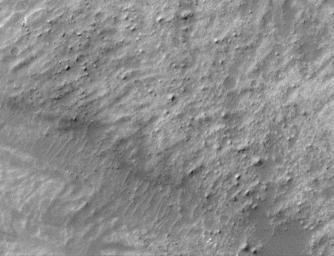
|
1.5 Meter Per Pixel View of Boulders in Ganges Chasma
- Click the image above for a larger view
- Full-Res JPEG (668 x 513) (58.4 kB)
- Full-Res TIFF (668 x 513) (321.5 kB)
Caption:
The Mars Orbiter Camera (MOC) on board the Mars Global Surveyor (MGS) spacecraft was designed to be able to take pictures that "bridge the gap" between what could be seen by the Mariner 9 and Viking Orbiters from space and what could be seen by landers from the ground. In other words, MOC was designed to be able to see boulders of sizes similar to and larger than those named "Yogi" at the Mars Pathfinder site and "Big Joe" at the Viking 1 landing site. To see such boulders, a resolution of at least 1.5 meters (5 feet) per pixel was required.
With the start of the MGS Mapping Phase of the mission during the second week of March 1999, the MOC team is pleased to report that "the gap is bridged." This image shows a field of boulders on the surface of a landslide deposit in Ganges Chasma. Ganges Chasma is one of the valleys in the Valles Marineris canyon system. The image resolution is 1.5 meters per pixel. The boulders shown here range in size from about 2 meters (7 feet) to about 20 meters (66 feet) in size. The image covers an area 1 kilometer (0.62 miles) across, and illumination is from the upper left.
Background Info:
Malin Space Science Systems and the California Institute of Technology built the MOC using spare hardware from the Mars Observer mission. MSSS operates the camera from its facilities in San Diego, CA. The Jet Propulsion Laboratory's Mars Surveyor Operations Project operates the Mars Global Surveyor spacecraft with its industrial partner, Lockheed Martin Astronautics, from facilities in Pasadena, CA and Denver, CO.
Cataloging Keywords:
| Name | Value | Additional Values |
|---|---|---|
| Target | Mars | |
| System | ||
| Target Type | Planet | |
| Mission | Mars Global Surveyor (MGS) | Mariner, Mars Pathfinder (MPF), Viking |
| Instrument Host | Mars Global Surveyor | |
| Host Type | Orbiter | Flyby Spacecraft |
| Instrument | Mars Orbiter Camera (MOC) | |
| Detector | ||
| Extra Keywords | Dust, Grayscale | |
| Acquisition Date | ||
| Release Date | 2000-09-16 | |
| Date in Caption | ||
| Image Credit | NASA/JPL/MSSS | |
| Source | photojournal.jpl.nasa.gov/catalog/PIA01674 | |
| Identifier | PIA01674 | |
